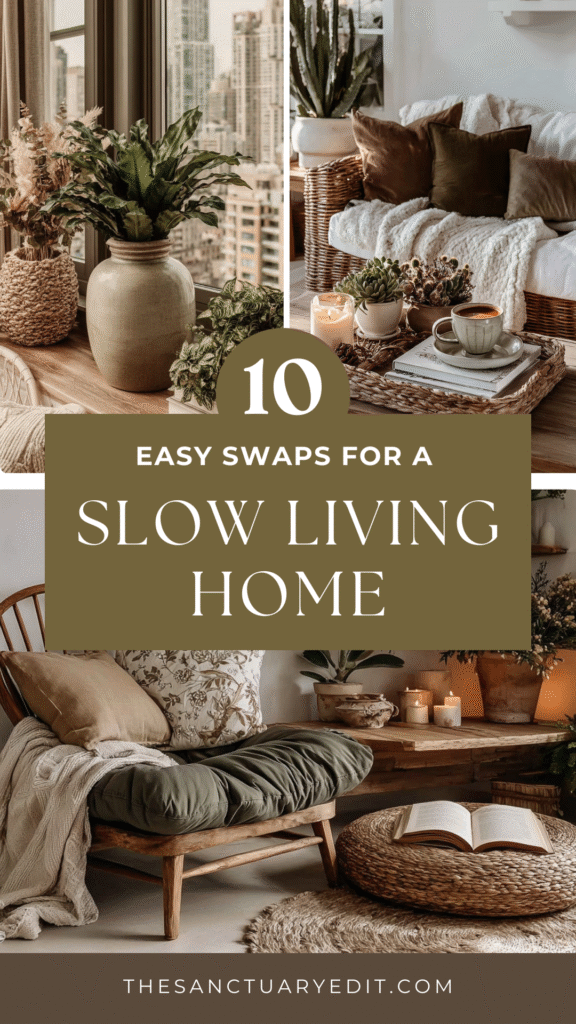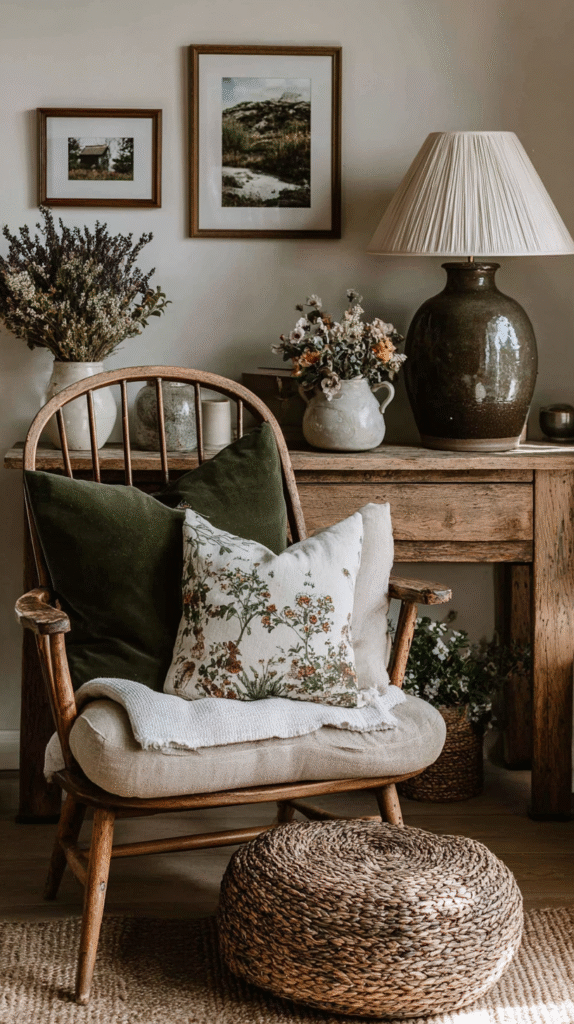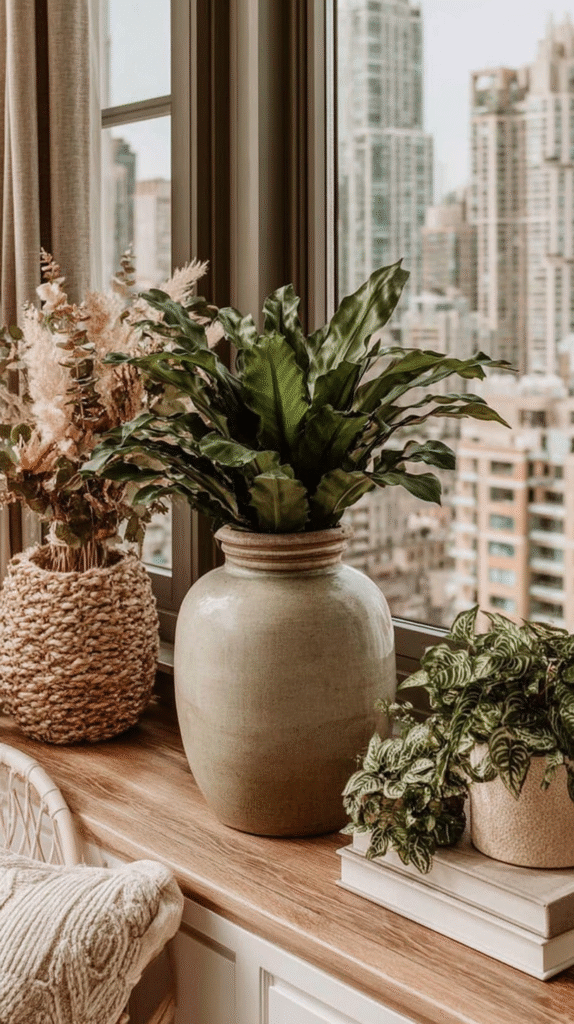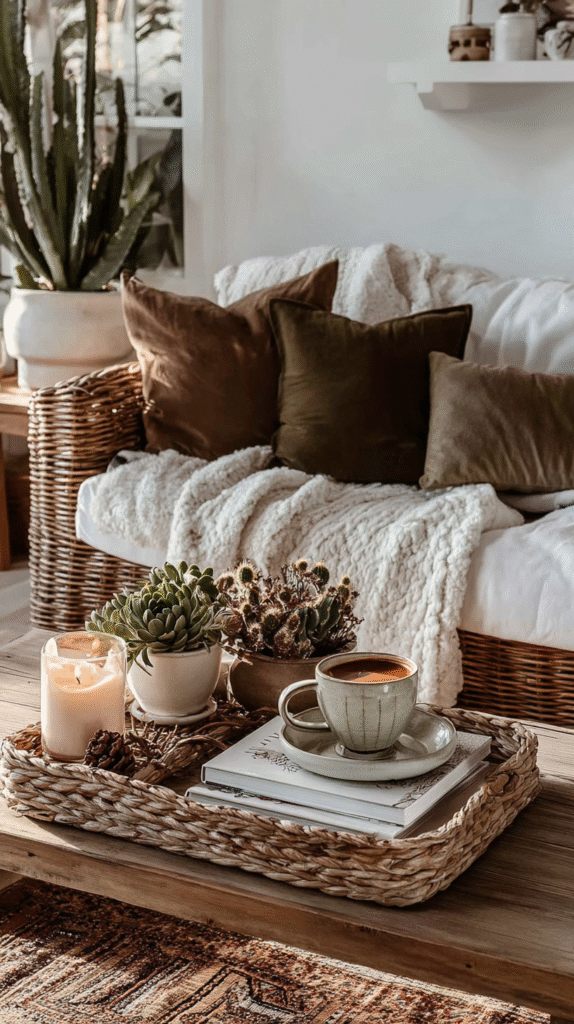This post may contain affiliate links, including those from Amazon Associates. If you make a purchase through these links, I may earn a commission at no additional cost to you. Learn more about our affiliate policy.
Some evenings you walk through the door and your body still feels like it is bracing.
The light is harsh, the counters are full, and the buzz of the day follows you inside. A slow living home is not about perfection. It is about small edits that help your nervous system soften, so the space around you supports rest instead of tension.
This post gathers ten simple swaps that bring peace without requiring a full redesign. Each one is rooted in calm design, natural materials, and gentle rhythms that help your home feel like the sanctuary you crave.
What Makes a Peaceful Slow Living Home
Slow living at home is less about how it looks and more about how it feels.
Spaces that invite you to exhale usually share a few qualities: natural light, soft and grounding textures, calm colour palettes, and surfaces with breathing room. They also carry intention, every piece has a place, a reason, or a rhythm.
Instead of chasing trends, the goal is to create a lived-in environment that helps you feel grounded. The following swaps offer achievable steps to move closer to that sense of peace.

1. Swap Harsh Lighting for Warm, Gentle Light
Overhead lights that glare can keep your nervous system on high alert.
Replace bright white bulbs with warm-toned LEDs or soft dimmable lamps. Use table and floor lamps in the evenings to create layers of glow rather than a single harsh source.
Candles, beeswax tealights, or salt lamps also provide a soothing alternative. This one change can make a room feel instantly softer and more welcoming.
2. Swap Busy Patterns for Natural Textures
Instead of piling on patterns, let texture do the work.
Linen curtains, a wool throw, or a jute rug bring depth without visual noise. Natural textures connect the senses to something grounding like cool stone, warm wood, the nubby feel of cotton.
This approach allows your eye to rest, and it helps the space feel layered without overwhelm.
If you want to take textures further, these affordable organic modern decor swaps show simple ways to layer natural materials without clutter.
3. Swap Fast Furniture for Pieces with Character

Flat-pack furniture may fill a room quickly, but often it adds little soul.
Choose pieces made of wood, rattan, or reclaimed materials. Thrifted or secondhand furniture brings both sustainability and story into your space.
If budget feels limiting, focus on one item at a time like a solid wooden chair, a vintage side table, or a handmade ceramic stool.
Building slowly is part of the slow living ethos.
4. Swap Synthetic Scents for Natural Aromas
Strong artificial scents can feel intrusive. Instead, use essential oils, beeswax candles, or fresh herbs to introduce fragrance.
Eucalyptus branches in a vase, lavender sachets in the bedroom, or rosemary drying in the kitchen add natural scent and beauty.
These subtle aromas not only calm the senses but also reduce the hidden chemicals that often come with synthetic products.
5. Swap Cluttered Surfaces for Clear Breathing Room
Visual clutter creates cognitive overload. Try giving every surface at least one clear zone. Keep a tray for small daily objects, but allow negative space to dominate.
Baskets, lidded boxes, or furniture with hidden storage help corral necessities while leaving your eyes a place to rest.
This is a gentle path toward decluttering without the overwhelm of an all-at-once purge.
6. Swap Cold Colours for Calming Earth Tones
Paint and textiles influence mood more than we realize. Instead of stark whites or high-contrast shades, choose muted tones: soft beige, sage green, warm clay, or gentle blue-grey.
Before painting a full wall, test how a colour shifts in natural light throughout the day. The right palette can change a room from stimulating to soothing in an instant.
7. Swap Artificial Decor for Living Elements

Plastic greenery or mass-produced wall art can leave a space feeling flat. Introduce life with plants, seasonal branches, or even a bowl of fresh fruit on the counter.
Biophilic design, bringing nature inside, has been shown to regulate stress and improve focus.
Even one thriving plant by the window can remind you to slow down and notice the rhythms of growth.
For more ideas on bringing greenery inside, explore these easy indoor plants that elevate earthy decor.
8. Swap Screens for Restorative Zones
Constant digital input keeps the mind buzzing.
Try creating at least one corner that is free of screens. A reading chair with a basket of books, a journaling nook, or a meditation cushion by the window offers a tech-free pause.
Even a small ritual like leaving your phone in another room at night signals to your nervous system that it is safe to rest.
9. Swap Impulse Buys for Thoughtful Purchases

Slow living also means slow consuming.
Before adding something new to your home, pause and ask: does this item serve a purpose, bring beauty, or feel aligned with my values?
Choosing fewer but better pieces helps reduce decision fatigue and supports a home that evolves with intention rather than accumulation.
10. Swap Chaotic Schedules for Rhythms of Rest
The home is not only about objects but also about flow.
Create rhythms that invite pause: tea in the same chair each morning, stretching on the rug before bed, lighting a candle after clearing the table.
Designating spaces for these micro-routines reinforces the feeling of sanctuary.
They anchor your day and remind you that peace is built through repetition, not perfection.
You might also find inspiration in these slow living evening routines that help signal calm at the end of the day.
How to Keep the Changes Manageable
The temptation is to overhaul everything at once, but slow living resists that pressure.
Start with one swap that feels most urgent. Notice how it shifts the atmosphere of your home. Then layer in another when you are ready.
Working room by room or season by season prevents overwhelm. Your home becomes an evolving reflection of what grounds you, rather than a finished project.
Closing
Peaceful homes are not created overnight. They are shaped through gentle edits, mindful swaps, and rhythms that build over time. Every shift has the power to change how you feel inside your space.
Let your home grow into a place where your nervous system can exhale. A slow living home is never about having more. It is about allowing less to become enough.


